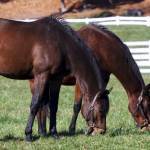Grazing Behavior in Horses

An article in Journal of Equine Veterinary Science presented information on production and environmental impacts of grazing that might be of interest to horse owners and property managers. Some of the information is summarized below.
- Given a choice, horses prefer not to graze in areas that are close to piles of manure. Because 98% of parasite larvae found in pastures are within one meter (3.25 ft) of manure, horses can avoid ingesting these larvae by grazing on some areas and defecating in others.
- Though horses allowed free access to pasture graze more or less continuously, peak grazing periods occur just after dawn and just before dark. They spend about 70% of daylight hours and about 50% of night hours grazing.
- It is estimated that a horse spends about 10 to 17 hours each day grazing, and this is broken up into about 15 to 20 grazing periods.
- Equines that have had their grazing time restricted tend to eat with great intensity when they have access to pasture, and can ingest a quantity of grass far above what the average horse eats in a comparable amount of time.
- Pastures should have a mixture of cool-season grasses, warm-season grasses, and legumes. Horses like to eat legumes, showing a preference for alfalfa and white clover over red clover.
- In a pasture study following two years of grazing by horses, tall fescue, meadow fescue, Kentucky bluegrass, and orchardgrass were the most persistent grasses. These grasses also have the highest yield in areas of the midwestern United States. Meadow bromegrass, perennial ryegrass, and quackgrass were moderately persistent, while timothy, smooth bromegrass, and reed canarygrass were least persistent.








